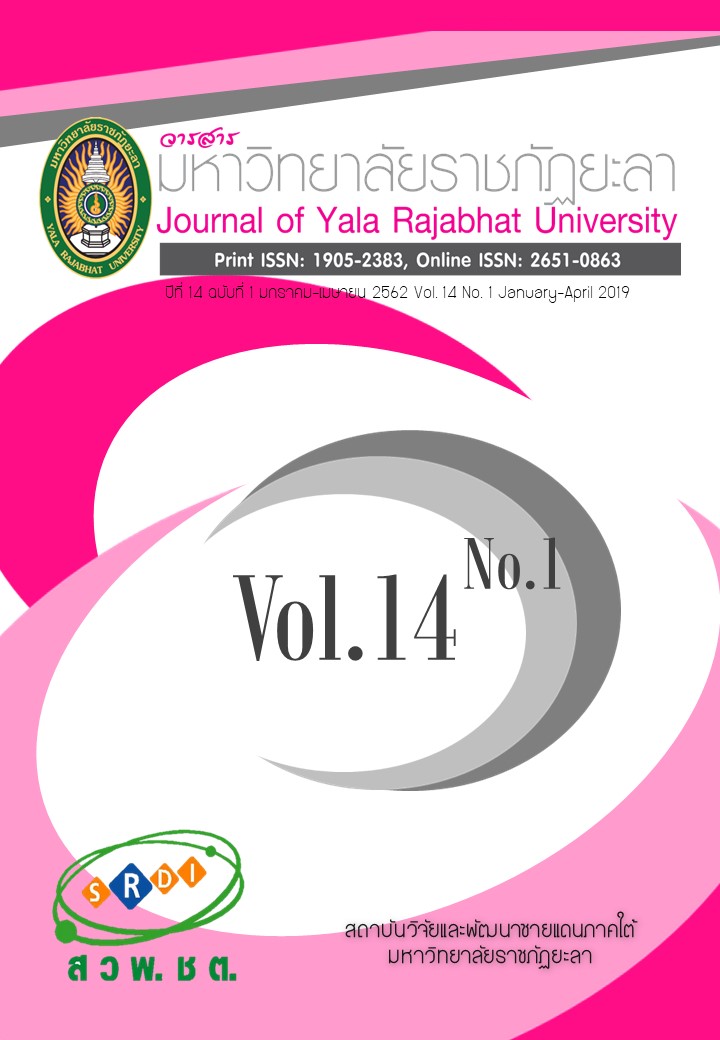องค์ประกอบปัจจัยด้านสถานการณ์แวดล้อมที่ส่งผลต่อพฤติกรรมใฝ่เรียนรู้ของนักศึกษาหลักสูตรอิสลามศึกษาในสถาบันอุดมศึกษา สามจังหวัดชายแดนภาคใต้
Main Article Content
บทคัดย่อ
การวิจัยนี้มีวัตถุประสงค์เพื่อศึกษาองค์ประกอบเชิงสำรวจของปัจจัยด้านสถานการณ์แวดล้อมที่ส่งผลต่อพฤติกรรมใฝ่เรียนรู้ของนักศึกษาปริญญาตรีหลักสูตรอิสลามศึกษาในจังหวัดชายแดนภาคใต้ และตรวจสอบองค์ประกอบเชิงยืนยันของโมเดลปัจจัยด้านสถานการณ์แวดล้อมที่ส่งผลต่อพฤติกรรมใฝ่เรียนรู้ของนักศึกษาปริญญาตรีหลักสูตรอิสลามศึกษาในจังหวัดชายแดนภาคใต้ โดยเก็บข้อมูลจากกลุ่มตัวอย่างซึ่งเป็นนักศึกษาระดับปริญญาตรีสาขาอิสลามศึกษาในสถาบันอุดมศึกษาพื้นที่สามจังหวัดชายแดนภาคใต้ โดยใช้แบบสอบถาม จำนวน 300 ชุด วิเคราะห์ข้อมูลโดยการวิเคราะห์องค์ประกอบเชิงสำรวจ (EFA) และวิเคราะห์องค์ประกอบเชิงยืนยัน (CFA) ผลการวิจัยพบว่า องค์ประกอบของปัจจัยด้านสถานการณ์แวดล้อมที่ส่งผลต่อพฤติกรรมใฝ่เรียนรู้ของนักศึกษาหลักสูตรอิสลามศึกษาในสถาบันอุดมศึกษาสามจังหวัดชายแดนภาคใต้ ประกอบด้วย 3 องค์ประกอบย่อย 12 ตัวบ่งชี้ ได้แก่ องค์ประกอบการสนับสนุนจากครอบครัว 4 ตัวบ่งชี้ องค์ประกอบบรรยากาศการเรียนรู้ 4 ตัวบ่งชี้ และองค์ประกอบการปฏิสัมพันธ์ของผู้สอน 4 ตัวบ่งชี้ นอกจากนี้ ผลการตรวจสอบโมเดลองค์ประกอบเชิงยืนยัน พบว่า ค่าดัชนีวัดระดับความสอดคล้องมีความกลมกลืนอยู่ในเกณฑ์ดีและผ่านเกณฑ์การพิจารณาทุกค่า คือ X2/df = 1.255 P= .104 CFI=.946 AGFI=.965 GFI=.965 IFI=.992 TLI=.990 RMSEA=.029 และ RMR=.024 โดยบรรยากาศการเรียนที่เอื้อต่อการเรียนรู้เป็นองค์ประกอบที่มีค่าสัมประสิทธ์มากที่สุด รองลงมาคือ การสนับสนุนจากครอบครัว และการปฏิสัมพันธ์ของผู้สอน ตามลำดับ จึงควรส่งเสริมให้สถาบันอุดมศึกษาในสามจังหวัดชายแดนภาคใต้พัฒนาการจัดสภาพแวดล้อมที่จะเป็นประโยชน์ในการเสริมสร้างบรรยากาศการเรียนรู้และพัฒนาศักยภาพการเรียนรู้ของผู้เรียนในสถาบันอุดมศึกษาจังหวัดชายแดนภาคใต้
Article Details
บทความ ข้อมูล เนื้อหา รูปภาพ ฯลฯ ที่ได้รับการเผยแพร่ในวารสารมหาวิทยาลัยราชภัฏยะลานี้ ถือเป็นลิขสิทธิ์ของวารสารมหาวิทยาลัยราชภัฏยะลา หากบุคคลหรือหน่วยงานใดต้องการนำทั้งหมดหรือส่วนหนึ่งส่วนใดไปเผยแพร่ต่อหรือกระทำการใดๆ จะต้องได้รับอนุญาตเป็นลายลักษณ์อักษรจากวารสารมหาวิทยาลัยราชภัฏยะลาก่อนเท่านั้น
เอกสารอ้างอิง
2. Bandura, A. (1986). Social foundations of thought and action: A social cognitive theory. Englewood Cliffs, NJ: Prentice Hall.
3. Bhanthumnavin, D. (2007). Interactionism model and Guideline in Hypothesized in the Psycho-Behavioral Science Research in Thailand. Journal of Social Development, 9(1), 85-117. (in Thai)
4. Brown, G. T. L. (2004). Measuring attitude with positively packed self-report ratings: Comparison of agreement and frequency scales. Psychological Reports, 94, 1015-1024.
5. Chantarattana, R. (2015). Factors Influencing Lateral Thinking of Student in Yala Rajabhat University. Journal of Yala Rajabhat University, 10(2), 91-106. (in Thai)
6. Diamantopoulos, A. & Siguaw, A. D. (2000). Introducing LISREL: A guide for the uninitiated. London. UK: Sage.
7. Fisher, K. (2005). Linking pedagogy and space. Department of education and training. Melbourne, Australia [Online]. Retrieved January 11, 2017, from: Eduweb.vic.gov.au/edulibrary.
8. Hair, J. F., Anderson, R.E., Tatham, R. L. & Black, W.C. (2010). Multivariate data analysis (7th ed.). New Jersey: PrenticeHall.
9. Hu, L. & Bentler, P. M. (2009). Cutoff criteria for fit indexes in covariance structure analysis: Conventional criteria versus new alternatives. Structural Equation Modeling: A Multidisciplinary Journal, 16(4), 1-55.
10. Huber, E. & Stephens, J. D. (1993). Political Parties and Public Pensions: A Quantitative Analysis. Acta Sociologica, 36, 309-325.
11. Ministry of Education. (2008). Towards a learning society in Thailand. Bangkok: Information Center at office of the permanent secretary ministry of education [Online]. Retrieved March 15, 2016, from: https://www.moe.go.th/.
12. Muntner, M. (2008). Teacher-Student Interactions: The Key to Quality Classrooms. The University of Virginia, Center for Advanced Study of Teaching and Learning (CASTL) [Online]. Retrieved April 25, 2017, from: https://www.readingrockets.org/article/teacher-student-interactions-key-quality-classrooms.
13. Popun, W. (2012). The characteristics of Active Learning student in undergraduates level. Master’s thesis. King Mongkut’s University of Technology North. (in Thai)
14. Shaugnessy, L. O. (2008). The College Solution. A Guide for Everyone Looking for the Right School at the Right Price [Online]. Retrieved January 25, 2016, from: https://www.thecollegesolution.com/.
15. Sinchai, S. (2012). General Psychology. Institute for Population and Social Research. Bangkok: Mahidol University. (in Thai)
16. Ubonsai, K. (2012). Psychological Characteristics and Work Situations as Correlates of Teachers’ Sufficiency Economy Socialization and Its Consequence On Students’ Attitudetoward Teachers’ Sufficiency Economy Socialization. Master’s thesis. Srinakharinwirot University. (in Thai)
17. Ukraisa, S. & Rangsayaton, S. (2009). Family relationship and adversity quotient, and prevention of commit suicide at-risk of public University students. Kasetsart Journal: Social Sciences, 30(2), 156-168. (in Thai)
18. Vygotsky, L. (1978). Interaction between learning and development. Mind and. Society Cambridge, MA: Harvard University Press.
19. Webb, A. & Moallem, M. (2016). Feedback and feed-forward for promoting problem-based learning in online learning environments. Malaysian Journal of Learning and Instruction, 13(2), 1-41.
20. Wiratchai, N. & Vongvanich, S. (2012). Misconceptions in Educational Research. Bangkok: National Research Council of Thailand. (in Thai)


